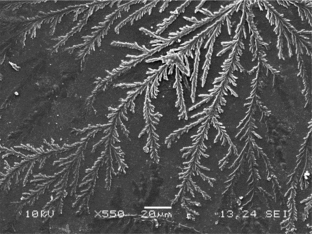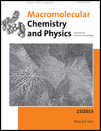2D Self-Assembly of an Amido-Ended Hydrophilic Hyperbranched Polyester by Copper Ion Induction
Junna Li
Key Laboratory of Catalysis and Materials Science of the State Ethnic Affairs Commission & Ministry of Education, South-Central University for Nationalities, Wuhan, Hubei Province, 430074, China
Search for more papers by this authorCorresponding Author
Daohong Zhang
Key Laboratory of Catalysis and Materials Science of the State Ethnic Affairs Commission & Ministry of Education, South-Central University for Nationalities, Wuhan, Hubei Province, 430074, China
Daohong Zhang, Key Laboratory of Catalysis and Materials Science of the State Ethnic Affairs Commission & Ministry of Education, South-Central University for Nationalities, Wuhan, Hubei Province, 430074, China
Sufang Chen, Key Laboratory for Green Chemical Process of Ministry of Education, Wuhan Institute of Technology, Wuhan, Hubei 430073, China.
Search for more papers by this authorShunhai Li
Key Laboratory of Catalysis and Materials Science of the State Ethnic Affairs Commission & Ministry of Education, South-Central University for Nationalities, Wuhan, Hubei Province, 430074, China
Search for more papers by this authorZhicai Xu
Key Laboratory of Catalysis and Materials Science of the State Ethnic Affairs Commission & Ministry of Education, South-Central University for Nationalities, Wuhan, Hubei Province, 430074, China
Search for more papers by this authorCorresponding Author
Sufang Chen
Key Laboratory of Catalysis and Materials Science of the State Ethnic Affairs Commission & Ministry of Education, South-Central University for Nationalities, Wuhan, Hubei Province, 430074, China
Key Laboratory for Green Chemical Process of Ministry of Education, Wuhan Institute of Technology, Wuhan, Hubei 430073, China
Daohong Zhang, Key Laboratory of Catalysis and Materials Science of the State Ethnic Affairs Commission & Ministry of Education, South-Central University for Nationalities, Wuhan, Hubei Province, 430074, China
Sufang Chen, Key Laboratory for Green Chemical Process of Ministry of Education, Wuhan Institute of Technology, Wuhan, Hubei 430073, China.
Search for more papers by this authorTingcheng Li
Key Laboratory of Catalysis and Materials Science of the State Ethnic Affairs Commission & Ministry of Education, South-Central University for Nationalities, Wuhan, Hubei Province, 430074, China
Search for more papers by this authorJunheng Zhang
Key Laboratory of Catalysis and Materials Science of the State Ethnic Affairs Commission & Ministry of Education, South-Central University for Nationalities, Wuhan, Hubei Province, 430074, China
Search for more papers by this authorShenghui Chen
Key Laboratory of Catalysis and Materials Science of the State Ethnic Affairs Commission & Ministry of Education, South-Central University for Nationalities, Wuhan, Hubei Province, 430074, China
Key Laboratory for Green Chemical Process of Ministry of Education, Wuhan Institute of Technology, Wuhan, Hubei 430073, China
Search for more papers by this authorAiqing Zhang
Key Laboratory of Catalysis and Materials Science of the State Ethnic Affairs Commission & Ministry of Education, South-Central University for Nationalities, Wuhan, Hubei Province, 430074, China
Search for more papers by this authorJunna Li
Key Laboratory of Catalysis and Materials Science of the State Ethnic Affairs Commission & Ministry of Education, South-Central University for Nationalities, Wuhan, Hubei Province, 430074, China
Search for more papers by this authorCorresponding Author
Daohong Zhang
Key Laboratory of Catalysis and Materials Science of the State Ethnic Affairs Commission & Ministry of Education, South-Central University for Nationalities, Wuhan, Hubei Province, 430074, China
Daohong Zhang, Key Laboratory of Catalysis and Materials Science of the State Ethnic Affairs Commission & Ministry of Education, South-Central University for Nationalities, Wuhan, Hubei Province, 430074, China
Sufang Chen, Key Laboratory for Green Chemical Process of Ministry of Education, Wuhan Institute of Technology, Wuhan, Hubei 430073, China.
Search for more papers by this authorShunhai Li
Key Laboratory of Catalysis and Materials Science of the State Ethnic Affairs Commission & Ministry of Education, South-Central University for Nationalities, Wuhan, Hubei Province, 430074, China
Search for more papers by this authorZhicai Xu
Key Laboratory of Catalysis and Materials Science of the State Ethnic Affairs Commission & Ministry of Education, South-Central University for Nationalities, Wuhan, Hubei Province, 430074, China
Search for more papers by this authorCorresponding Author
Sufang Chen
Key Laboratory of Catalysis and Materials Science of the State Ethnic Affairs Commission & Ministry of Education, South-Central University for Nationalities, Wuhan, Hubei Province, 430074, China
Key Laboratory for Green Chemical Process of Ministry of Education, Wuhan Institute of Technology, Wuhan, Hubei 430073, China
Daohong Zhang, Key Laboratory of Catalysis and Materials Science of the State Ethnic Affairs Commission & Ministry of Education, South-Central University for Nationalities, Wuhan, Hubei Province, 430074, China
Sufang Chen, Key Laboratory for Green Chemical Process of Ministry of Education, Wuhan Institute of Technology, Wuhan, Hubei 430073, China.
Search for more papers by this authorTingcheng Li
Key Laboratory of Catalysis and Materials Science of the State Ethnic Affairs Commission & Ministry of Education, South-Central University for Nationalities, Wuhan, Hubei Province, 430074, China
Search for more papers by this authorJunheng Zhang
Key Laboratory of Catalysis and Materials Science of the State Ethnic Affairs Commission & Ministry of Education, South-Central University for Nationalities, Wuhan, Hubei Province, 430074, China
Search for more papers by this authorShenghui Chen
Key Laboratory of Catalysis and Materials Science of the State Ethnic Affairs Commission & Ministry of Education, South-Central University for Nationalities, Wuhan, Hubei Province, 430074, China
Key Laboratory for Green Chemical Process of Ministry of Education, Wuhan Institute of Technology, Wuhan, Hubei 430073, China
Search for more papers by this authorAiqing Zhang
Key Laboratory of Catalysis and Materials Science of the State Ethnic Affairs Commission & Ministry of Education, South-Central University for Nationalities, Wuhan, Hubei Province, 430074, China
Search for more papers by this authorAbstract
The self-assembly of an amido-ended hydrophilic hyperbranched polyester (HTDA-2) into ordered, compact, 2D, tree-like structures with a diameter of over 500 μm and a trunk-width of about 3–5 μm by the induction effect of cupric ions is presented. Influencing factors on the morphology of the self-assemblies, including temperature, time, solvents, concentration, and humidity, investigated by polarizing optical microscopy (POM) and scanning electron microscopy (SEM), are discussed. The self-assembly mechanism is analyzed by X-ray photoelectron spectroscopy (XPS), X-ray diffraction (XRD), SEM, and Fourier transform IR (FTIR) spectroscopy. A dimension (Df) of about 1.50 for the perfect fractal behavior and the crystal behavior of the self-assemblies are determined.
References
- 1 T. Aida, E. Meijer, S. Stupp, Science 2012, 335, 813.
- 2 H. Jin, W. Huang, X. Zhu, Y. Zhou, D. Yan, Chem. Soc. Rev. 2012, 41, 5986.
- 3 D. Konkolewicz, M. J. Monteiro, S. B. Perrier, Macromolecules 2011, 44, 7067.
- 4 Y. Mai, A. Eisenberg, Chem. Soc. Rev. 2012, 41, 5969.
- 5 B. I. Voit, A. Lederer, Chem. Rev. 2009, 109, 5924.
- 6 Y. Zhou, D. Yan, Chem. Commun. 2009, 1172.
- 7 C. Chen, G. Liu, X. Liu, S. Pang, C. Zhu, L. Lv, J. Ji, Polym. Chem. 2011, 2, 1389.
- 8 S. Chen, S. X. Cheng, R. X. Zhuo, Macromol. Biosci. 2011, 11, 576.
- 9 R. Wang, X. Jiang, B. Yu, J. Yin, Soft Matter 2011, 7, 8619.
- 10 S. Peleshanko, V. V. Tsukruk, J. Polym. Sci., Part B: Polym. Phys. 2012, 50, 83.
- 11 W. Tao, Y. Liu, B. Jiang, S. Yu, W. Huang, Y. Zhou, D. Yan, J. Am. Chem. Soc. 2012, 134, 762.
- 12 Y. Zhou, W. Huang, J. Liu, X. Zhu, D. Yan, Adv. Mater. 2010, 22, 4567.
- 13 V. Percec, D. A. Wilson, P. Leowanawat, C. J. Wilson, A. D. Hughes, M. S. Kaucher, D. A. Hammer, D. H. Levine, A. J. Kim, F. S. Bates, Science 2010, 328, 1009.
- 14 G. Widawski, M. Rawiso, B. François, Nature 1994, 369, 387.
- 15 C. Liu, C. Gao, D. Yan, Angew. Chem. Int. Ed. 2007, 46, 4128.
- 16 N. Maruyama, T. Koito, J. Nishida, T. Sawadaishi, X. Cieren, K. Ijiro, O. Karthaus, M. Shimomura, Thin Solid Films 1998, 327, 854.
- 17 D. Zhang, J. Li, S. Chen, T. Li, J. Zhou, X. Cheng, A. Zhang, Macromol. Chem. Phys. 2013, 214, 370.
- 18 D. Zhang, J. Wang, S. Chen, X. Cheng, T. Li, J. Zhang, A. Zhang, Langmuir 2012, 28, 16772.
- 19 M. A. Kostiainen, P. Hiekkataipale, J. A. de la Torre, R. J. M. Nolte, J. J. L. M. Cornelissen, J. Mater. Chem. 2011, 21, 2112.
- 20 M. J. Jasmine, E. Prasad, J. Phys. Chem. B 2010, 114, 7735.
- 21 G. Jiang, X. Sun, Y. Wang, M. Ding, Polym. Chem. 2010, 1, 1644.
- 22 I. Manners, Science 2001, 294, 1664.
- 23 R. Angamuthu, P. Byers, M. Lutz, A. L. Spek, E. Bouwman, Science 2010, 327, 313.
- 24 S. Park, J. H. Lim, S. W. Chung, C. A. Mirkin, Science 2004, 303, 348.
- 25 W. J. Parak, Science 2011, 334, 1359.
- 26 R. Mezzenga, J. Ruokolainen, G. H. Fredrickson, E. J. Kramer, D. Moses, A. J. Heeger, O. Ikkala, Science 2003, 299, 1872.
- 27 S. Mann, Nat. Mater. 2009, 8, 781.
- 28 D. Zhang, D. Jia, Eur. Polym. J. 2006, 42, 711.
- 29 D. Zhang, D. Jia, S. Chen, Macromol. Chem. Phys. 2009, 210, 1159.
- 30 L. Zhang, A. Eisenberg, J. Am. Chem. Soc. 1996, 118, 3168.
- 31
L. Zhang,
A. Eisenberg,
Polym. Adv. Technol.
1998,
9,
677.
10.1002/(SICI)1099-1581(1998100)9:10/11<677::AID-PAT845>3.0.CO;2-# CAS Web of Science® Google Scholar
- 32 Y. Yu, L. Zhang, A. Eisenberg, Macromolecules 1998, 31, 1144.
- 33 P. Bhargava, J. X. Zheng, P. Li, R. P. Quirk, F. W. Harris, S. Z. Cheng, Macromolecules 2006, 39, 4880.
- 34 K. Khanna, S. Varshney, A. Kakkar, Polym. Chem. 2010, 1, 1171.
- 35 K. C. F. Leung, K. N. Lau, Polym. Chem. 2010, 1, 988.
- 36 A. Z. Samuel, S. Ramakrishnan, Macromolecules 2012, 45, 2348.
- 37 B. Jiang, W. Tao, X. Lu, Y. Liu, H. Jin, Y. Pang, X. Sun, D. Yan, Y. Zhou, Macromol. Rapid Commun. 2012, 33, 767.
- 38 T. A. Witten, L. M. Sander, Phys. Rev. B 1983, 27, 5686.
- 39 A. Lomander, W. M. Hwang, S. G. Zhang, Nano Lett. 2005, 5, 1255.
- 40 T. Freeman, S. Evans, A. Ulman, Thin Solid Films 1994, 244, 784.
- 41 T. Freeman, S. Evans, A. Ulman, Langmuir 1995, 11, 4411.
- 42 M. Srinivasarao, D. Collings, A. Philips, S. Patel, Science 2001, 292, 79.
- 43 T. A. Witten Jr., L. M. Sander, Phys. Rev. Let. 1981, 47, 1400.
- 44 L. Gao, L. Shi, Y. An, W. Zhang, X. Shen, S. Guo, B. He, Langmuir 2004, 20, 4787.
- 45 M. Schor, P. G. Bolhuis, Phys. Chem. Chem. Phys. 2011, 13, 10457.





